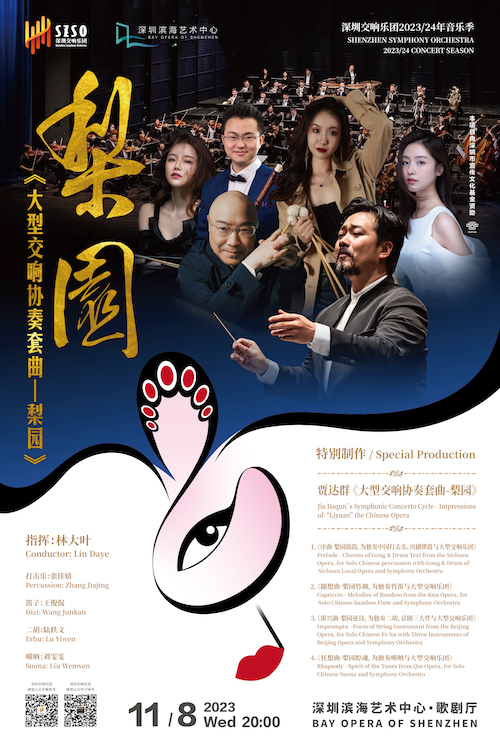
| 数量: |
开售时间:
2023年10月5日(周四)上午11:00
购票特惠:
*适用所有优惠券,可与任意折扣叠加,限微信购票使用。
演出时长:
*总时长约90分钟,无中场休息;
*一人一券,1.2米以下儿童谢绝进场;
*本项目由深圳市宣传文化基金资助。
【演出曲目】 Programme
贾达群《大型交响协奏套曲-梨园》
Jia Daqun’s Symphonic Concerto Cycle - Impressions of “Liyuan” the Chinese Opera
1.《序曲·梨园鼓韵,为独奏中国打击乐、川剧锣鼓与大型交响乐团》
Prelude - Charms of Gong & Drum Text from the Sichuan Opera, for Solo Chinese percussion with Gong & Drum of Sichuan Local Opera and Symphony Orchestra
2.《随想曲·梨园竹调,为独奏竹笛与大型交响乐团》
Capriccio - Melodies of Bamboo from the Kun Opera, for Solo Chinese bamboo Flute and Symphony Orchestra
3.《即兴曲·梨园弦诗,为独奏二胡、京剧三大件与大型交响乐团》
Impromptu - Poem of String Instrument from the Beijing Opera, for Solo Chinese Er-hu with Three Instruments of Beijing Opera and Symphony Orchestra
4.《狂想曲·梨园腔魂,为独奏唢呐与大型交响乐团》
Rhapsody - Spirit of the Tunes from Qin Opera, for Solo Chinese Suona and Symphony Orchestra
*曲目以现场为准
*Program is subject to change
指挥:林大叶
Conductor:Lin Daye
打击乐:张佳婧
Percussion: Zhang Jiajing
笛子:王俊侃
Dizi: Wang Junkan
二胡:陆轶文
Erhu: Lu Yiwen
唢呐:刘雯雯
Suona: Liu Wenwen
【作品介绍】Music
贾达群
JIA Daqun
上海音乐学院二级教授,特聘专家,博士生导师;上海音乐学院贺绿汀中国音乐高等研究院高级研究员;南京艺术学院特聘教授;享受国务院政府特殊津贴;兼任中国音乐家协会作曲与作曲理论学会副会长、音乐分析专委会主任;中国人文社会科学期刊评价(音乐与舞蹈学)专家委员会委员,教育部人文社科重点基地(中央音乐学院音乐研究所)学术委员,《音乐研究》《音乐艺术》《音乐探索》等学术期刊编委,上海音乐出版社签约作者。
创作了各种体裁和风格的音乐作品。《弦乐四重奏》1991年获日本“第十二届IRINO室内乐国际作曲比赛”大奖,《蜀韵》被评为“20世纪华人经典”,《回旋曲》《龙凤图腾》《两乐章交响曲》《巴蜀随想》等在国家和省部级作曲比赛中获奖。重要的委约创作包括:《无词歌》(日本文化厅),《响趣》(法国巴黎音乐城),《漠墨图》I-II(美国马友友丝路乐团),《融I》(荷兰Atlas室内乐团),《融II》(日本现代音乐协会),《融III》(爱尔兰国家文旅部),《水墨画意三则》(美国亚洲文化基金会、古根海姆基金、美国朱莉亚新室内乐团),《梦蝶》(台湾当代传奇剧场),《云起》(新西兰国家艺术基金),《钢琴前奏曲三首》(日本SONY唱片),《蝶恋传奇》(国家艺术基金、上海交响乐团),《梨园》(上海大剧院艺术中心艺术发展基金、上海民族乐团),《逐浪心潮》(上海交响乐团)等。出版个人音乐作品专辑唱片和视频光盘7张(Naxos,2015,2016,2017,SMPH&SLAV,2019,2020),出版各类音乐作品乐谱20余部。主要创作有:大型交响乐作品4部、室内交响曲2部、协奏曲7部、民族器乐协奏曲4部、歌剧1部、舞剧2部、声乐套曲1部、弦乐四重奏4部、打击乐作品5部、各种室内乐14部等。
撰写有数十篇(部)有关音乐创作和分析的研究论文与著述。论文《结构对位》获教育部第五届高校人文社科优秀成果二等奖(2009)、《结构分析学导引》获中国音乐金钟奖理论银奖(2011)、专著《结构诗学》获教育部第六届高校人文社科优秀成果三等奖(2013)、专著《作曲与分析》获上海市第十四届哲学社会科学优秀成果奖学科学术一等奖(2018)和教育部第八届高校人文社科优秀成果二等奖(2020)。出版有关音乐理论和分析的学术专著两部:《结构诗学》(2009)和《作曲与分析》(2016)。
其它相关奖项还有:“四川省有突出贡献的优秀专家”(1996),美国亚洲基金会、古根海姆基金创作研究奖(2005),教育部“全国百篇优秀博士论文指导教师奖”(2007),宝钢优秀教师奖(2008),上海市优秀文艺人才奖(2010),上海市育才奖(2014)等。完成上海市教委科研项目两项(《结构分析对我国新世纪音乐创作的核心价值》(2007)、《音乐的观念及其形式化程序》(2015)),国家社科基金艺术学项目一项(《音乐结构:形态、构态、对位以及二元性》(2015)),国家艺术基金大型舞台音乐创作一项(《交响舞乐•蝶恋传奇》(2017-18)),以及上海市重大文艺创作一项(室内乐《秋兴八首·男中音与钢琴》(2020))。作为课题首席专家,新近获得国家社科艺术学重大项目《中国特色作曲理论体系研究》(2021-2025)。
贾达群曾任国务院学位委员会艺术学科评议组第五、六届成员(2003-2015),全国艺术专业研究生教育培养指导委员会委员(2005-2015),上海音乐学院研究生部主任(2001-2014),上海音乐学院学科办主任(2008-2014),浙江音乐学院(筹)副院长(2014.10-2016.03)。
贾达群:交响协奏套曲《梨园》
Jia Daqun’s Symphonic Concerto Cycle - Impressions of “Liyuan” the Chinese Opera
“协奏套曲”是贾达群创立的一种大型作品体裁,其定义为:一、套曲中包含数首为不同独奏乐器而作的协奏类乐曲;二、套曲中的数首协奏类作品具有统一的音乐主旨;三、套曲内每一首协奏类乐曲既可单独演奏,也可集合演奏;作为一个大型的集合作品,其作品总体结构应符合传统曲式中奏鸣套曲曲式的基本规范。
交响协奏套曲《梨园》是根据作者“大型民族器乐协奏套曲《梨园》”(2018-2019)改写而成,历时两年。原作作为新中国70周年华诞的献礼之作,由上海民族乐团委约,并获得上海大剧院艺术中心艺术发展基金的资助,也是上海音乐出版社的年度重点出版项目。
交响协奏套曲《梨园》包含四部协奏类乐曲,分别冠之以“序曲”“随想曲”“即兴曲”和“狂想曲”。分别采用中国传统戏曲中川剧、昆曲、京剧与秦腔的音乐素材予以重构、再造,其形式为独奏打击乐器加上川剧锣鼓打击乐组合、独奏竹笛、独奏二胡加上京剧三大件组合以及唢呐与大型交响乐团。
套曲中的四部乐曲名称及形式如下:
1.《序曲·梨园鼓韵,为独奏中国打击乐、川剧锣鼓与大型交响乐团》,演奏时长约11分钟。
2.《随想曲·梨园竹调,为独奏竹笛与大型交响乐团》,演奏时长约19分钟。
3.《即兴曲·梨园弦诗,为独奏二胡、京剧三大件与大型交响乐团》,演奏时长约17分钟。
4.《狂想曲·梨园腔魂,为独奏唢呐与大型交响乐团》,演奏时长约23分钟。
作品总时长为70分钟。
作者从中国传统文化之魂的戏曲艺术中获取当代传承的创作灵感,在架构作品结构时采用古老昆曲艺术的曲牌体程式化手法,套曲的结构原则充分体现了洋为中用的创作特色,四部乐曲的名称生动体现了中西合璧的风格特征。在标题中圆点前半部分呈现的是国际化语境下的普适性,在标题中圆点的后半部分则彰显了浓郁的中国梨园传统特色。运用中国传统戏曲中的素材来进行当代的音乐创作,既有利于弘扬中华传统文化、彰显中华民族艺术特色,又有利于让中国当代的音乐创作在世界乐坛上留下独特的印记。这便是作者创作《梨园》的初心。
独奏声部的写法既凸显了传统戏曲的腔韵和节奏特征,又极具当代专业音乐创作的表达方式,以此将传统和现代进行了个性化的融合。
作品的乐队写作部分,吸取并融合了不同民族乐器的演奏方式、风格韵味和音响特征,希冀通过这样的方式让西方管弦乐队发出鲜明而浓郁的中国管弦之声。
Jia Daqun: Symphonic Concerto Cycle – Impressions of “Liyuan” the Chinese Opera Concerto Cycle is a large-scale genre created by the composer Jia Daqun, which is defined as:
- It contains several concertos for different solo instruments;
- Several concertos in the cycle should have a unified theme;
- Each of the concertos can be performed individually or collectively, however, when performed as a cycle, the structure of the work must meet the basic requirements of the Sonata cycle of the traditional form.
The symphonic concerto cycle, which took two years to complete, is based on the composer's large-scale concerto cycle for traditional Chinese musical instruments on the same name (2018 - 2019). The original work, as a tribute to the 70th anniversary of the founding of the People’s Republic of China, was commissioned by the Shanghai National Orchestra and obtained the financial support by the Art Development Fund of Shanghai Grand Theatre. It is also the annual key publishing project of Shanghai Music Publishing House.
The Symphonic concerto cycle consists of four concertos titled “Prelude” “Capriccio” “Impromptu” and “Rhapsody”. The music materials of traditional Chinese operas such as Sichuan local opera, Kun opera, Beijing opera and Qin opera respectively used have been reconstructed and recreated. Formally, it is equipped with gong & drum of Sichuan local opera for solo Chinese percussion, three instruments of Beijing opera for solo bamboo flute and solo er-hu, solo suona with a large symphony orchestra.
The titles and forms of the four concertos in this cycle are as follows:
- Prelude - Charms of Gong & Drum Text from the Sichuan Opera, for Solo Chinese percussion with Gong & Drum of Sichuan Local Opera and Symphony Orchestra (about 11 minutes);
- Capriccio - Melodies of Bamboo from the Kun Opera, for Solo Chinese bamboo Flute and Symphony Orchestra, (about 19 minutes);
- Impromptu - Poem of String Instrument from the Beijing Opera, for Solo Chinese Er-hu with Three Instruments of Beijing Opera and Symphony Orchestra (about 17 minutes);
- Rhapsody - Spirit of the Tunes from Qin Opera, for Solo Chinese Suona and Symphony Orchestra (about 23 minutes)
The total length of the composition is about 70 minutes.
The composer obtains the creative inspiration of contemporary inheritance from the opera art, which is the soul of traditional Chinese culture; structurally, it adopts the stylized approach “Qupai” of the ancient Kun Opera, and takes the principle of “foreign things for Chinese use”. Besides, the titles of the four concertos also vividly reflect the characteristics of both Chinese and Western styles. The part before the dot in the title presents the universality in the international context, while the part after that highlights the strong traditional characteristics of “Liyuan” the Chinese Opera. Using materials from Chinese traditional operas to create contemporary music is not only conducive to promoting traditional Chinese culture and highlighting the artistic characteristics of the Chinese nation, but also beneficial to making contemporary Chinese music creation leave its unique mark on the world music scene. This is the original intention of the composer to create the “Liyuan” cycle.
The solo part is written in a way that highlights the vocal charms and rhythmic characteristics of traditional opera, but is also very contemporary and professional in its expression, thus personalizing the fusion of tradition and modernity.
The orchestra part of the work draws on and integrates the playing methods, expression styles and acoustic characteristics of different national musical instruments, so that the Western orchestra can emit a distinctive and rich Chinese orchestral sound.
1、演出票是观众进入剧场观演的唯一有效凭证。所有演出票一经售出,不退换、不记名、不挂失、不补办。请购票人务必妥善保管演出票,如因个人原因不慎将演出票丢失、损毁或遗失副券均无法进场观演。
2、选座购买请于15分钟内完成支付流程,否则座位将不作保留。
3、下单成功后,可凭取票码(电子票)至深圳滨海艺术中心售票厅的自助取票机兑换纸质票。
4、一人一票入场,凭票进入相应楼层,对号入座,严禁跨层入场。
5、请观众提前半小时入场,迟点可能会错过部分演出,须听从工作人员指引,有序进场,就近入座。
6、请勿将食品、有色饮料带入剧场,矿泉水允许带入剧场,请自行妥善保管。
咨询及服务热线:0755-23305639
我司提供增值税电子发票,如需开具,请下单时准确填写发票信息,并致电票务热线 0755-23305639 凭订单号提出开具发票需求,我们会于5个工作日内发送电子发票到您的邮箱。




